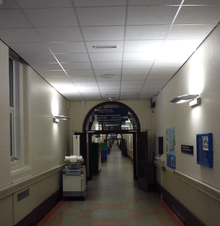Nottingham City Hospital
| Nottingham City Hospital | |
|---|---|
| Nottingham University Hospitals NHS Trust | |
 North Corridor | |
| Geography | |
| Location | Nottingham, England, United Kingdom |
| Organisation | |
| Care system | Public NHS |
| Hospital type | Teaching |
| Affiliated university | University of Nottingham |
| Services | |
| Emergency department | No Accident & Emergency |
| Beds | 1100 |
| History | |
| Founded | 1903 |
| Links | |
| Website |
www |
| Lists | Hospitals in England |
Nottingham City Hospital is a large hospital located in Nottingham, England. In 2006, it merged with the Queen's Medical Centre to form the Nottingham University Hospitals NHS Trust.
The City Hospital is the older and smaller of Nottingham's two hospitals, opened in 1903, but tracing its foundation to 1782 in the development of St Mary's, St. Nicholas, St. Peters & Union Workhouse, the Bagthorpe Isolation Hospital and the Bagthorpe Workhouse and Infirmary.[1] It began its life as a workhouse infirmary. It occupies a large 90-acre (360,000 m2) site on the ring road to the North of the city centre. It is composed of many buildings, most of which are joined together by long corridors. Buildings include a leisure club, a Maggies Centre for people with cancer, and a patient hotel, which opened in 1994, the first purpose built one in the UK.
Regional Centre
The hospital serves as the regional centre for cancer care, nephrology, infectious diseases, cardiothoracic surgery and burns; and is a national centre for shoulder surgery. It also serves as the hyperacute stroke unit, respiratory medicine unit, and elective urology centre for Nottingham. (Cardiology is mostly based at City, but Queens has the coronary care unit for Nottingham). Despite its size, the hospital has never had an Accident and Emergency (A&E) department. However it still provides maternity and neonatal facilities. Some patients such as stroke patients are admitted directly to City Hospital as opposed to the Queens Medical centre. The two hospitals work together and medics who work at the Queens Medical Centre are often called on to go to City.
The hospital has significant roles in teaching and research, in association with the University of Nottingham. Research interests include rheumatology, stroke, respiratory medicine and oncology. Medical students from the University of Nottingham Medical School are attached to most of the departments as part of their clinical training. Nursing students are also to be found on practice placements here.
There has been significant reorganisation of clinical services in Nottingham since the merger of the city's two hospitals in 2006. One change associated with this was the relocation of all children's services to the Queens Medical Centre. Some new buildings have risen on the City Hospital Campus in recent years: namely the Trent Cardiac Centre, Haematology Building, Maternity Unit, Clinical Sciences Building, Radiotherapy Centre and Cystic Fibrosis Unit. New theatres are currently being constructed at City. This reorganisation is expected to continue into the future. It is likely that burns will shortly move to the Queens Medical Centre so it can be located under the same roof as the trauma facilities. The two hospitals are connected by a link bus which provides a free service for patients and staff.
List of wards
- Acute Cardiac Unit
- Barclay Thoracic Ward (Thoracic Surgery)
- Berman 1 (Hyperacute Stroke Unit)
- Berman 2 (Respiratory)
- Beeston Ward (Stroke Rehab)
- Bonington Ward (Maternity)
- Bramley Ward (Renal)
- Burns Unit(Burns)
- Carrel Ward (Renal)
- Cardiac High Dependency Unit
- Cardiac Intensive Care Unit
- Critical Care Directorate 1 & 2
- Edward 2 Ward (Orthopaedic)
- Fleming Ward (Female Respiratory)
- Fletcher Ward (Haematology)
- Fraser Ward (Oncology)
- Gervis Pearson Ward (Oncology)
- Gillies Ward (Plastics)
- Harvey 1 & 2 Wards (Surgical)
- Hogarth Ward (Oncology & Teenage Cancer Trust Unit)
- Lambley Ward (Staff Training Unit)
- Lawrence Ward (Maternity)
- Linby Ward (Cardiac)
- Lister 1 & 2 Wards (Orthopaedic)
- Loxley Ward (Gynae)
- Morris Ward (Cardiology & AICU)
- Morton Ward (Renal)
- Newell Ward (Stroke Rehab)
- Nightingale Ward (Infectious Disease)
- Papplewick Ward (Cardiology)
- Patience 1 & 2 Wards
- Seacole (Acute Stroke Unit)
- Simpson Ward 1 (Elective Admissions)
- Simpson Ward 2
- Southwell Ward (Male respiratory)
- Specialist Receiving Unit (SRU)
- St. Francis Wards
- Toghill Ward (Heamatology)
- Winifred 1 & 2 Wards (General Surgery)
See also
References
- ↑ "The Nottingham City Hospital". Paul R. Swift. Retrieved 16 March 2014.